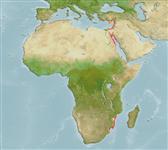Common names from other countries
Environment: milieu / climate zone / depth range / distribution range
Ecologie
; diepteverspreiding 1 - 100 m (Ref. 83938). Tropical; 46°N - 30°S, 32°E - 37°E (Ref. 275)
Circumglobal in warm to temperate waters.
Length at first maturity / Size / Gewicht / Leeftijd
Maturity: Lm ? range ? - ? cm Max length : 18.0 cm ML mannelijk/geslacht niet bekend; (Ref. 105659); common length : 80.0 cm TL mannelijk/geslacht niet bekend; (Ref. 417); Maximaal gepubliceerd gewicht: 2.0 kg (Ref. 275)
Minimum depth from Ref. 104052. Also caught by artisanal fishing gears (spears, hooks, lures, and traps; Ref. 417). Maximum total length ranges from 120 to 150 cm (Ref. 3722). Found in coralline bottoms (Ref. 417), coral reefs, sandy and rubble bottoms, particularly in subtidal areas (Ref. 83938).
Life cycle and mating behavior
Geslachtsrijpheid | Voortplanting | Kuitschieten | Eieren | Fecundity | Larven
Members of the class Cephalopoda are gonochoric. Male and female adults usually die shortly after spawning and brooding, respectively. Mating behavior: Males perform various displays to attract potential females for copulation. During copulation, male grasp the female and inserts the hectocotylus into the female's mantle cavity where fertilization usually occurs. Life cycle: Embryos hatch into planktonic stage and live for some time before they grow larger and take up a benthic existence as adults.
Schneider, W. 1990. (Ref. 417)
Status op de Rode Lijst van het IUCN (Ref. 130435)
Status bij CITES (Ref. 108899)
Not Evaluated
Not Evaluated
Gebruik door de mens
Visserij: commercieel
| FishSource | Sea Around Us
Tools
Meer informatie
Leeftijd/GrootteGroeiLengte-gewicht parametersLengte-lengte parametersMorfologieLarvenAbundantie
Internet-bronnen
Estimates based on models
Preferred temperature
(Ref.
115969): 20.3 - 26.4, mean 24.5 (based on 60 cells).
Kwetsbaarheid
Low vulnerability (10 of 100).
